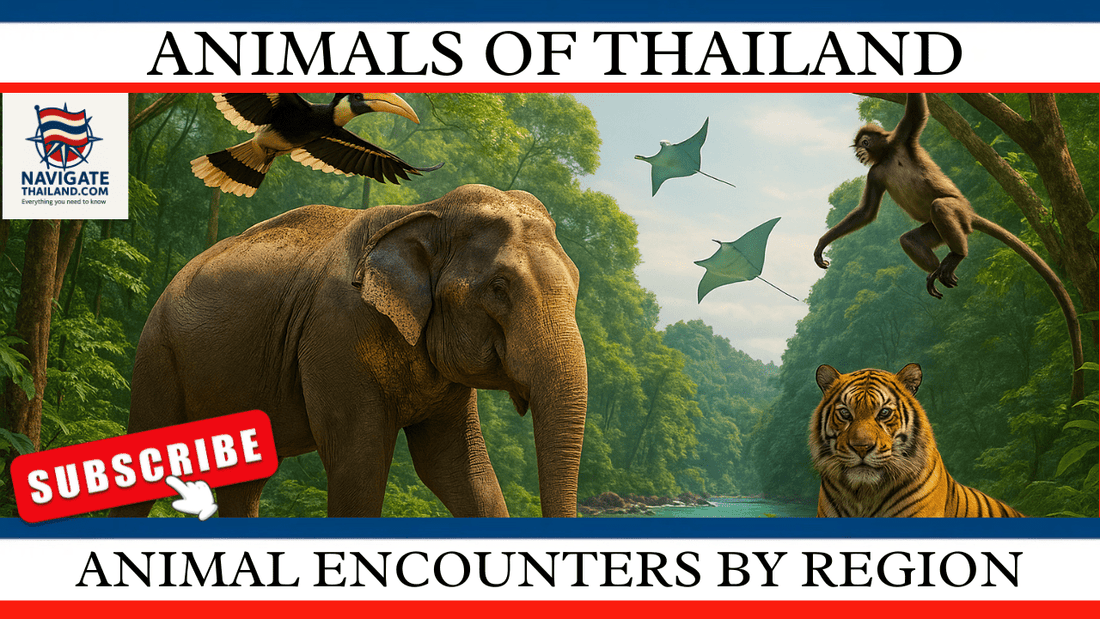
From Monkeys to Manta Rays: Animal Encounters by Region
Share
Thailand is home to an astonishing variety of wildlife—from the misty mountains of the north to the turquoise reefs of the Andaman Sea. Whether you’re hiking through jungle trails or diving into coral-rich waters, every region offers its own unique chance to meet the wild side of Thailand.
This guide breaks down the best animal encounters by region—ideal for nature lovers, wildlife photographers, and curious travellers alike.
🐘 Northern Thailand: Elephants, Gibbons & Jungle Birds
The mountainous terrain and dense forests of Northern Thailand provide rich habitats for many iconic land animals.
Key Encounters:
-
Asian Elephants
Chiang Mai and Chiang Rai are home to ethical elephant sanctuaries like Elephant Nature Park, where you can observe rescued elephants roaming freely. -
White-Handed Gibbons
Listen for their loud calls in Doi Inthanon National Park, and if you’re lucky, you may spot them swinging through the treetops. -
Great Hornbills
These majestic birds are a common sight in Huai Kha Khaeng Wildlife Sanctuary, a UNESCO site that also shelters leopards and other rare species.
Fun Fact: Thailand’s northern forests are part of the Indo-Burma Biodiversity Hotspot, one of the most biologically rich areas in the world.
🐒 Central Thailand: Macaques, Bats & Urban Wildlife
While Bangkok is a bustling metropolis, the surrounding provinces offer surprising animal encounters.
Key Encounters:
-
Crab-Eating Macaques
In Lopburi, these monkeys famously roam the streets and temple ruins. Don’t miss the annual Monkey Buffet Festival held each November! -
Bats of Khao Yai
As night falls, witness over 2 million bats streaming from the caves of Khao Yai National Park, one of the country’s top wildlife-viewing destinations. -
Monitor Lizards
Bangkok’s Lumphini Park is a great place to spot these prehistoric-looking reptiles sunning themselves near the water.
🐅 Western Thailand: Tigers, Bears & Hidden Sanctuaries
Dense rainforests and remote mountain ranges make western Thailand a haven for more elusive species.
Key Encounters:
-
Indochinese Tigers
While rarely seen, Thung Yai-Huai Kha Khaeng Wildlife Sanctuaries are known habitats. This is one of the last strongholds for Thailand’s tiger population. -
Asiatic Black Bears & Leopards
Explore Kaeng Krachan National Park, Thailand’s largest national park and a vital corridor for many endangered animals.
Travel Tip: Visit with a certified guide to increase your chances of wildlife sightings in these lesser-explored areas.
🦧 Southern Thailand: Dusky Langurs, Sea Turtles & Rainforest Life
The limestone karsts, mangroves, and rainforests of the south are bursting with biodiversity both above and below the surface.
Key Encounters:
-
Dusky Langurs
Spot these shy primates with white-rimmed eyes in Khao Sok National Park, a paradise for jungle trekking and canoeing. -
Leatherback Sea Turtles
Visit Phang Nga or Ranong during nesting season (November to February) to witness turtles laying eggs on quiet beaches. -
Hornbills and Civets
The Hala-Bala Wildlife Sanctuary in the far south is known as the “Amazon of ASEAN,” home to rare hornbill species and elusive mammals.
🐠 Islands & Oceans: Manta Rays, Whale Sharks & Reef Life
Thailand’s marine parks offer once-in-a-lifetime diving and snorkeling experiences.
Andaman Sea (West Coast):
-
Manta Rays & Whale Sharks
Dive the Similan Islands and Koh Bon for encounters with these ocean giants. Peak visibility runs from February to May. -
Moray Eels, Reef Sharks & Seahorses
Koh Phi Phi and Koh Lanta offer easy access to vibrant reefs teeming with underwater life.
Gulf of Thailand (East Coast):
-
Pink Dolphins
A rare sight in Khanom, pink Indo-Pacific humpback dolphins are often spotted by longtail boat. -
Nudibranchs & Colorful Corals
For macro marine life, dive off Koh Tao, a hotspot for diving schools and underwater photographers.
Eco Tip: Choose marine tour operators that support reef-safe sunscreen and marine conservation initiatives.
🐾 Respectful Encounters & Ethical Tourism
While animal encounters can be unforgettable, it’s vital to ensure your interactions are ethical:
✅ Choose sanctuaries that prohibit riding, chains, or animal performances.
✅ Avoid feeding or touching wild animals.
✅ Support conservation efforts through entry fees or donations.
Remember: The best wildlife experiences are those that leave no trace.
Conclusion
From misty mountains echoing with gibbon calls to coral reefs gliding with manta rays, Thailand is a living showcase of biodiversity. No matter which region you explore, animal lovers will find extraordinary moments waiting around every corner—if they look (and listen) closely.
So whether you’re trekking in Chiang Mai or diving off Koh Lanta, make time to connect with Thailand’s incredible wildlife. You’ll leave with not just photos, but powerful memories of the animals that call this country home.
📍 Have a favorite animal encounter in Thailand?
Tell us about it in the comments below or tag us on social media using #NavigateThailandWildlife.
Read more of our Thailand blog series:
Thai Food Guide:Traditional Recipes and Street Eats
Everything Travellers Need to know
Thailand travel ebooks and language guides
Thailand Travel Apparel & Souvenir Gifts
Subscribe to our YouTube channel Navigate Thailand to see our most popular Thailand travel blogs turned into videos:
Navigate Thailand YouTube channel

















































































































































